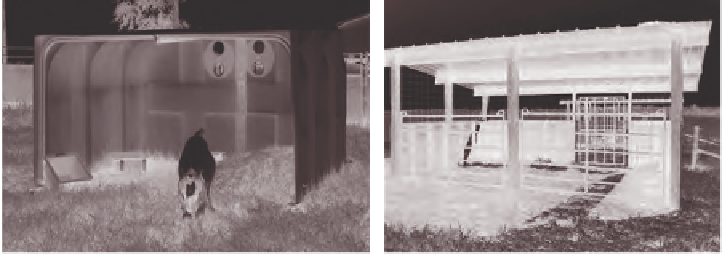Agriculture Reference
In-Depth Information
Portable
Permanent
Figure 17.2
Shelters for goats. Courtesy: Sandra Solaiman. For color detail, see Appendix A.
conversions are made, equipment should be thoroughly
inspected to ensure that they are safe for goats or humans.
Loose fl ooring or protruding metal parts can be potentially
hazardous. Goat shelters should be considered places for
the animals to escape rain, heat, and other environmental
elements, not places for them to live. Goats thrive in an
outdoor environment where they can browse on vegeta-
tion. Total confi nement livestock systems for goats cause
decreased thriftiness and lead to a general decline in health
if the units are not constructed and managed properly.
Some producers may wish to construct a permanent barn
if there are no existing agricultural structures on the farm-
stead. This can be costly in both time and money. However,
when not in use for goat housing, such structures can be
used for equipment and hay storage or as a maintenance
shop. Items such as medicines or pesticides stored on the
farm should not be stored in a barn near livestock and
should be kept out of reach of children and unauthorized
persons at all times.
Fencing
There are two main purposes for fencing an area for goat
production. The fi rst and main purpose is to keep the
animals in a desired area, and it may help minimize preda-
tors with boundary fencing. The second purpose is for
controlled grazing management. Proper boundary fencing
in a goat production setting is a major capital investment.
However, cost will depend on the materials used. Six-
strands of high tensile electric fence is less expensive than
woven fence. Investigating fencing laws and consideration
of adjacent landowners is important when establishing
boundary fencing to avoid confl icts of interest and future
disputes with neighbors. Always investigate cost-sharing
opportunities. In the U.S., the Natural Resource
Conservation Service (NRCS) offi ces will provide useful
information with availability of cost share funds and tax
credit availability for fencing and water delivery to
livestock.
A perimeter fence should be at least 5-6 feet (1.5-1.8 m)
tall depending on the intensity of four-legged or two-
legged predators. A permanent 4-foot (1.2-m) woven wire
with one or two strands of barbed or electric wire along
the top will be a good perimeter fence. A strand of barbed
wire at the bottom will provide more durability. The use
Permanent Structures
Permanent shelters can be constructed on pastures. The
shelter should be constructed to provide at least the
minimum space allowance for group housing (Table 17.2).
It should have three closed sides with 4 feet (1.2 m) of
wood/metal wall completed with 2-4 feet (0.6-1.2 m) of
woven wire (half wood and half wire) for adequate ventila-
tion. The leeward side should be open and only closed by
hanging gates. The rear eave height of 1.2 - 1.8 m (4 - 6 feet)
and front eave height of 1.8-2.4 m (6-8 feet) is ideal and
provides for a slanted roof and moving in cleaning equip-
ment. Metal roofi ng with at least a 24 - 36 cm (2 - 3 feet)
overhang on the side will best protect against extreme
weather conditions (Figure 17.2). As indicated earlier, a
good prepared gravel bed and concrete fl ooring, sloped for
drainage are ideal; however, they are more expensive and
require bedding. But, it is easier to clean and disinfect
when needed, especially to prevent disease and parasites.
Dirt fl oors will work as well, but they may get wet and
stay wet if not designed properly for drainage, and they
need more frequent bedding changes. Elevated slatted
fl oors are an excellent choice in more tropical and rainy
environments.







